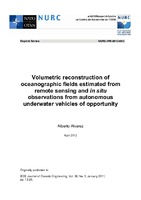| dc.contributor.author | Alvarez, Alberto | |
| dc.date.accessioned | 2018-10-11T14:09:43Z | |
| dc.date.available | 2018-10-11T14:09:43Z | |
| dc.date.issued | 2012/04 | |
| dc.identifier | 42935 | |
| dc.identifier.govdoc | NURC-PR-2012-003 | |
| dc.identifier.uri | http://hdl.handle.net/20.500.12489/666 | |
| dc.description.abstract | A main challenge of military oceanography (MILOC) is to assess the oceanographic conditions of denied/highrisk marine regions. Monitoring technologies are limited to those that can provide access to these regions. Remote sensing and autonomous underwater vehicles (AUVs) can support MILOC requirements. Unfortunately, the environmental information gathered by these technologies is not complete: remote sensing provides information about some surface conditions and water-column integrated variables, whereas operational priorities often constrain AUVs use during real crisis situations to missions with higher priority than environmental assessment. Under this scenario, data fusion techniques to maximize the information of the collected data are essential. This paper attempts to reconstruct thermal fields fusing data gathered by remote sensing platforms and AUVs performing missions not specifically designed for environmental data collection. The technique estimates the state that maximizes the posterior probability subjected to some smoothing constraints. A variational methodology allows remote sensing information to serve as boundary constraints. The approach uses 3-D finite elements to solve the maximization problem. The procedure investigated has been tested with different smoothing constraints in a simulated environment and in a real field experiment conducted by the Muscle AUV in the Gulf of Riga (Baltic Sea) on April 19, 2008. Results highlight the relevance of incorporating the surface information provided by remote sensors into the estimation. | |
| dc.format | 16 p. : ill. (digital, PDF file) | |
| dc.language | English | |
| dc.publisher | NURC | |
| dc.source | In: IEEE Journal of Oceanic Engineering, Vol. 36, No. 1, January 2011, pp. 13-25. | |
| dc.subject | Autonomous Underwater Vehicles (AUV) | |
| dc.subject | Remote sensing | |
| dc.subject | Data fusion | |
| dc.subject | Environmental Information (EI) | |
| dc.subject | Finite element method | |
| dc.subject | Military Oceanography | |
| dc.title | Volumetric distribution of oceanographic fields estimated from remote sensing and in situ observations from autonomous underwater vehicles of opportunity | |
| dc.type | Reprint (PR) | |
| dc.type | Papers and Articles | |
